#Chinese cultural
Text
[mdzs] In depth analysis of Lan Xichen’s name
It’s been 2.5 years since my last MDZS name analysis(!!), and since then I’ve gotten so many requests from the fandom wanting to see more. So here’s to everyone who have enjoyed reading my posts so far - today I’ll be diving into Lan Xichen’s name. Sit back as this is an interesting one!

Lan Xichen is his zi ,or courtesy name, which means ‘chancellor of the morning sunlight’ (Xi 曦 - morning sunlight; Chen 臣- chancellor, minister).
It derives from the poem ‘Xian Qing Fu’ 《闲情赋》 (Ode to a Quiet Life) by Eastern Jin dynasty recluse poet Tao Yuan Ming 陶渊明. Tao is remembered for his appreciation of beauty and serenity of the natural world around him, often admiring the good of others and documenting his wishes for a peaceful and fair society. (NB: The majority of Chinese people would know of the phrase ‘世外桃源’ - Xanadu / fantastical place of great idyllic magnificence and beauty, which originated from him.) This particular poem is a long study on the beauty and virtues of an idealised woman, and is known today as one of the most iconic bodies of work celebrating a woman’s true inner qualities. “悲晨曦之易夕,感人生之长勤” (bēi chén xī zhī yì xī, gǎn rén shēng zhī cháng qín), translates figuratively to ‘it is regrettable that the light of this morning will soon be replaced by the dark night, reminding people that life is filled with endless fatigue.’
One can’t help but draw parallels to Xichen’s life - he was always a noble figure, approached people with sincerity, treated everyone with an equal level of respect and believed deeply in those he stayed close to. But life could not always pay back what he gave to others, as he learnt of his trusted friend Jin Guangyao’s corrupt ways and betrayal - the light that was replaced by darkness.
I find it fascinating how poet Tao’s perspective of the world is so similar to Xichen’s. Tao is known for spending much of his life in reclusion, living in the countryside, receiving only a few guests he had a strong bond with, reading and indulging in his love for poetry. As a talented and knowledgeable man, he spent a decade of his life as a politician - but soon lost faith in a system that was characterised by nepotism, violence, corruption and civil disorder. Torn between ambition and the desire to retreat into solitude, he chose the latter. I wonder if MXTX drew inspiration from this, as Xichen also began as a leader in the cultivators’ world, is a huge lover and collector of literature, and after all the turmoil also decided to withdraw into reclusion.
Xichen’s birth name is 涣 (Huàn), which has two main meanings: 1) ‘melting of snow’; 2) ‘water dispersing in all directions’. His title is 泽芜君 (zé wú jūn), which literally means ‘nourisher of barren lands’ (泽润 - to nourish, bestow; 平芜 - land overgrown with weeds). Combining the two, we can understand his name to mean ‘water disperses in all directions, nourishing everything it touches’. 泽 in Chinese is used specifically to describe bestowing something deep, long-lasting and meaningful (as supposed a one time gift/favour - which would be 惠). In the book, MXTX also describes him as “清煦温雅,款款温柔” (meaning ‘warm, gracious and elegant, gentle in all aspects’). Clearly, his name highlights the grace and kindness he radiates and bestows on everyone around him. He is the keeper of peace and righteousness.
Bonus:
Note that the word Huan 涣 has a water particle, similar to his brother Lan Wangji’s birth name Zhan 湛 - it brings to mind the ‘Twin Jades of Lan’ title for the brothers, with a water element - like Pisces.
Interestingly, in ‘I Ching’ or ‘Book of Changes’, the ancient Chinese divination text which contains of 64 hexagrams, there is a 涣 hexagram:

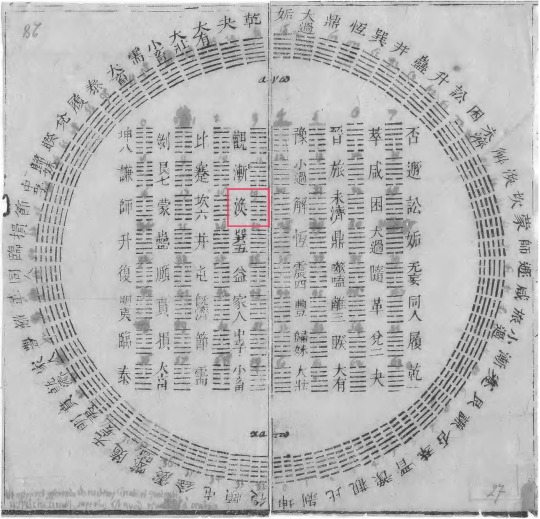
Again, it represents how gentleness can summon greatness. I copy the below from iching-online.com:

In simple terms, it symbolises water that washes away dirt and baptises new life within oneself. And the aftermath is precisely Zhan 湛 in his brother’s name, meaning crystal clear water.
Other name analyses:
Wei Wuxian
Lan Wangji
Jiang Wanyin
Lan Sizhui
#the untamed#mo dao zu shi#mdzs#mdzs meta#lan xichen#Chinese names#name analysis#male names#蓝曦臣#lan huan#蓝涣#魔道祖师#蓝湛#lan zhan#i ching#64 hexagrams#Chinese novel#Chinese drama#Chinese#Chinese cultural#陈情令#chen qing ling#cql
524 notes
·
View notes
Text
I want to post this here too because I’ve seen it happen a few times

Please understand that there are cultural differences and language differences, if you see this happening let the person clarify what they meant, that person might just not be familiar with words the western side of the internet use
#bearz rambling tag#no it’s not really possible to let everyone who uses this term to change#because as far as I know this is the most common word with use on Chinese websites#I didn’t know that pairing are called ‘ship’ here#like why would I even know that#‘ship’ makes zero sense to me#it took me a while to learn the fandom language people speak here#it’s hard#give people time#shipping culture is very different too#Like on Chinese site you HAVE to clarify the Top and the Bottom of this ship in the ship name#it is very very important to them#people who like the same ship but with different Top Bottom preference will fight till no end#imagine how confused I was when I first got here#where there’s no top bottom differences#it’s not really a smut thing#it’s more a dynamic thing#AxB and BxA is very different#oh I can talk so much about the differences on fandom cultures#if ya are interested in more please feel free to ask#it’s very interesting to me#I wanna talk about it
8K notes
·
View notes
Text

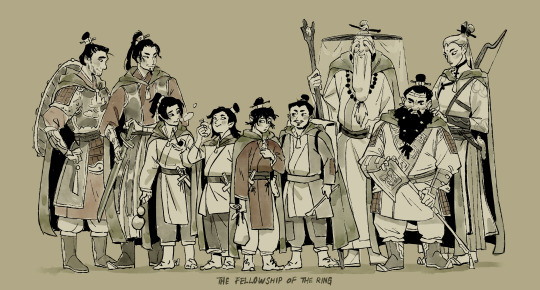


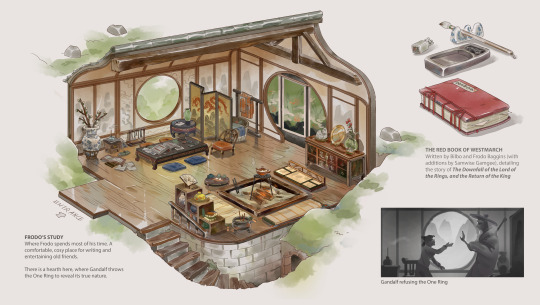

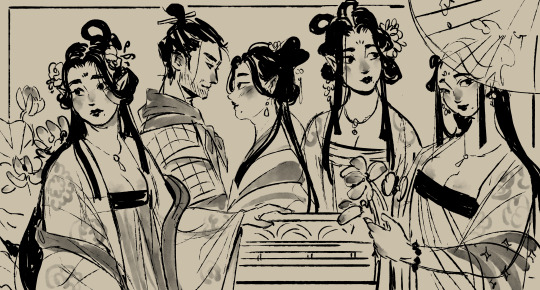
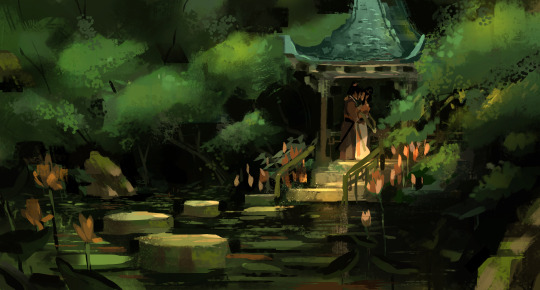


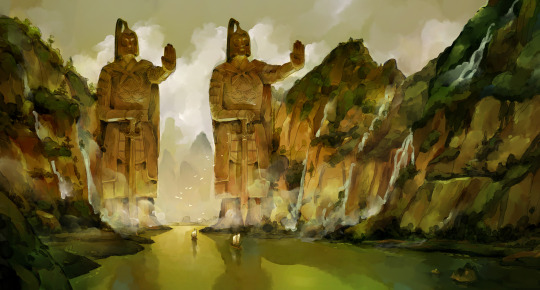
First Post!
I deleted my old tumblr because... man idk why it was covid-times and the prefrontal cortex was not in the room with us!! Anyways, I was reminded by my lovely friend @repecca that tumblr exists, and that some of my work has been going around on here, so I decided to post some of my work up officially!
Starting off with my most notable (?) work to date, here's my LOTR: The Middle Kingdom Project.
Now, it's been over a year since I posted this, and at the time I was... really searchingfor myself artistically, and I decided to go all in on something that I'd been ruminating on for a long time.
So, hello, again. I'm Leia. I do visual development/BG design, and I'm also a writer of things. I love fantasy and transformative work. It's nice to meet you.
#lotr#lord of the rings#the middle kingdom#chinese culture#hanfu#frodo#visual development#visdev#concept art
8K notes
·
View notes
Text
A winter reminder
English added by me :)
#eye strain#flashing#douyin#video#tiktok#含亮老师#dlkafjkl you do not knooooow the intense whiplash these collabs always give me#idk if they do this on tiktok but it's such like a part of douyin culture lolol#that and the health reminders from celebrities#the women's pingpong team like PUT YOUR PHONE DOWN TAKE A BREAK#hmmm typo..... tied should be tidied....#but the vibe is kind of still there so it's good it's cool i don't care#psa#chinese weapons
4K notes
·
View notes
Video
茶宠chachong/tea pet (clay handicrafts for chinese tea culture)
9K notes
·
View notes
Text
So for basically my whole life I'd grown up with and was resigned to accept that the chinese concept of formal/nice clothing of my and the previous generation has been western clothes. So at any awards ceremonies or performances, entertainers would show up mostly in western suits/dresses and maaaaaybe you'll spot the occasional cheongsam if they're going for a Wong Fei Hong vibe. Which, you know, kinda sucks if you have any concept of western cultural imperialism in asia.
So when the hanfu revivalist movement started, I was waiting to see when it would enter the mainstream -- my hope was for fashion designers to integrate traditional/dynastic elements into their work and make it common place enough that I can buy this shit online for ME. Because I WANT.
Though some of the designs can be a bit hit or miss, I am LOVING what various stars and entertainers are wearing out and about now.
Anyway - here's a collection of Xiao Shunyao's modern hanfu inspired/hybridized stage outfits from the last couple years. For his MLC performances, his stylists seem to be borrowing inspiration from his Di Feisheng and possibly other character costume silhouettes.

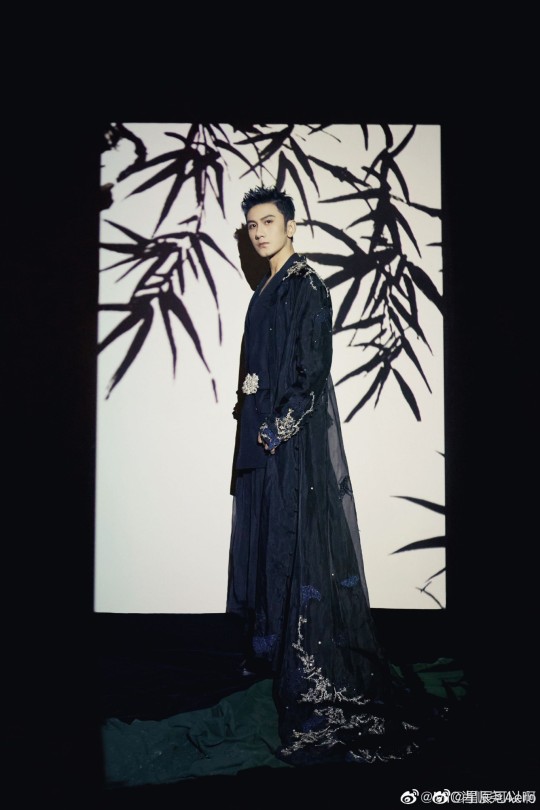
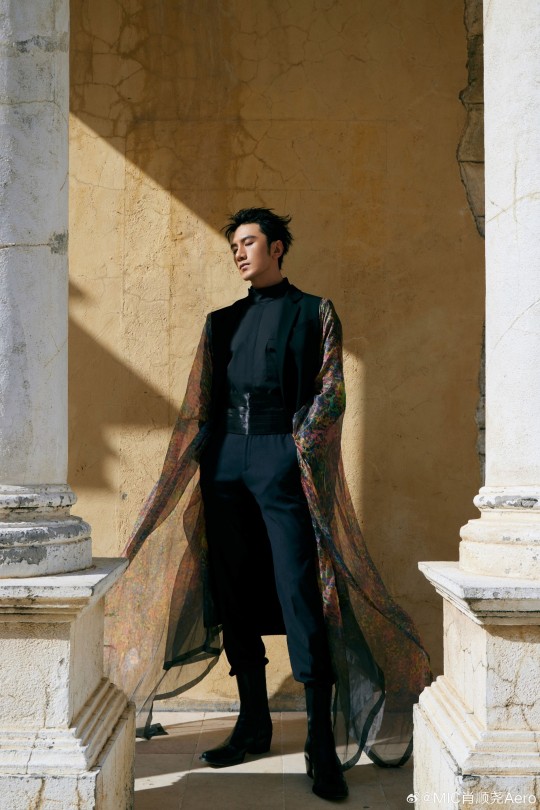
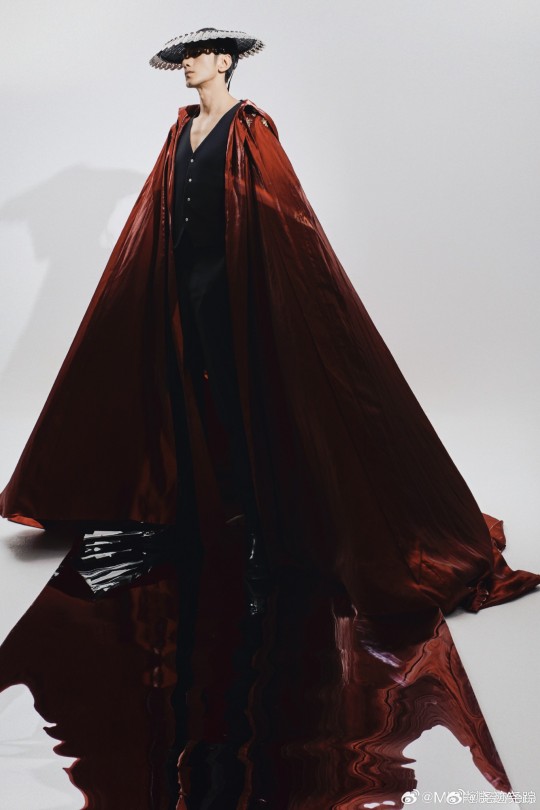

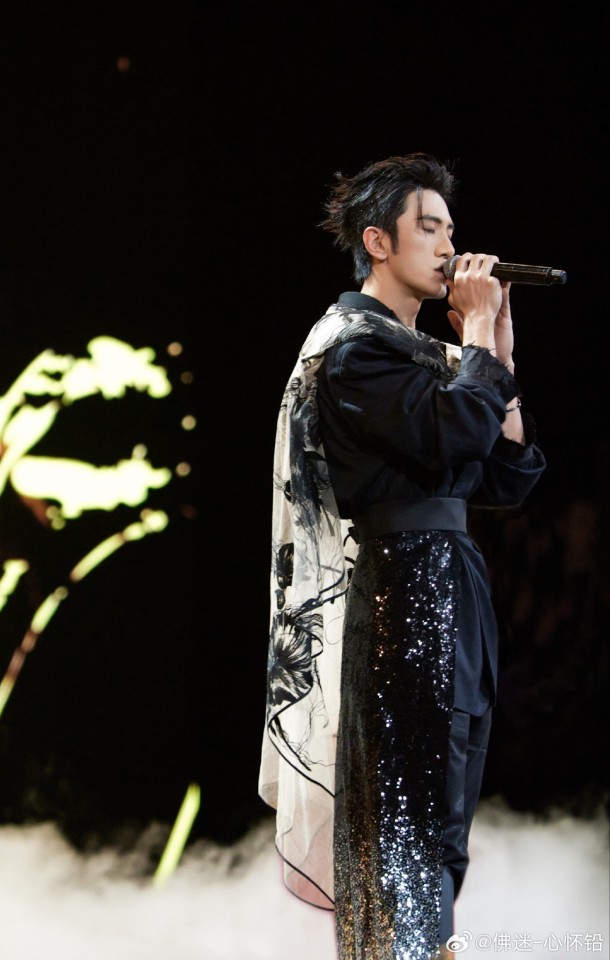


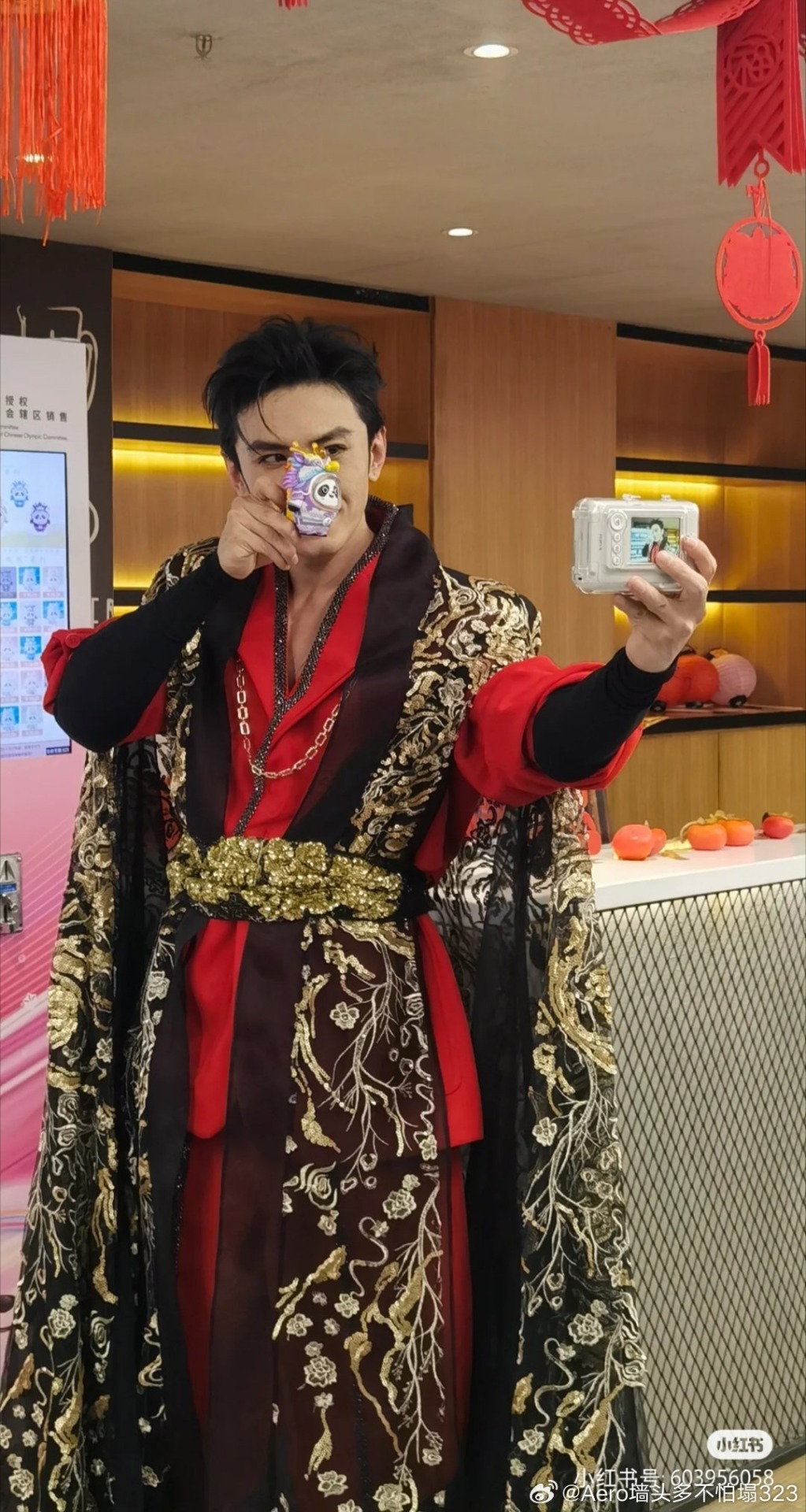
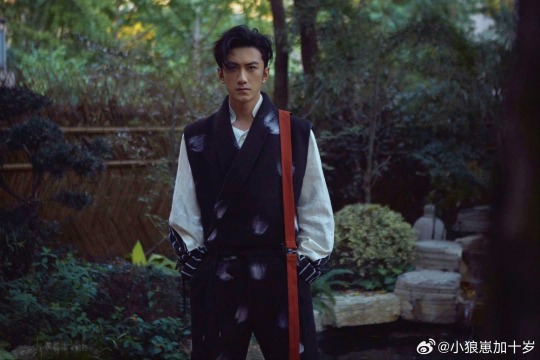
I'd been seeing a few comments about how his outfits play with gender - and some of his outfits do! But I think the interesting thing to discuss is from which standard is he playing with gender? Because from a western perspective, the things he does with his western suit tops, belting on top of the jacket for a tightly cinched waist, and the addition of a trailing skirt = femme. But if you're talking from a hanfu-hybridized pov, that's just a modern take on hanfu and having any of those elements is not inherently femme and would often read masc to me.
So these things aren't necessarily gendered because they exist traditionally in chinese men's clothing or costume designs (ie video games, comics, historical fiction illustrations and film, etc, so therefore in the modern lexicon of masculine/acceptable for men):
presence or lack of a skirt
silky, velvety, gauzy or sparkly material choice, esp in formal or stage clothing
short or long length of skirt
embroidery
flowers/floral/bird designs
folding fans
certain styles of makeup
beading, gold, tassels, jewels
non-chunky jewelry
headbands
widely flowing silhouettes
What XSY's stylists are doing with some western clothing items are interesting. I'm convinced there have been one or two western jacket tops made of thinner material that they're folding over the front, and belting down instead of buttoning (which then matches with his other outfits that are designed specifically to do this). Then they're adding a skirt, cloak or bracer element to it.
The western portions often bring a military minimalist feel which they balance with a more gauzy material in the skirt or cloak portions.
Things I think are playing with gender:
row 1 - image 1: red di feisheng-inspired outfit
The lace-up girdle is there to match the bracers in both material and style. And it's positioned to be similar to the heavy belt that Di Feisheng wears.
HOWEVER. That style of girdle/corset-like clothing item can't be divorced from the modern idea of sexy leather corsets. So imo, this waist piece on that outfit was a choice. Especially when paired with his allergic-to-collars-higher-than-his-sternum necklines. And if you take into context how masculine yet female coded his character is in the drama, the whole look evokes that.
row 2, image 1: black western suit with belt on top, hat, cloak, black boots and not-visible but also a black tassel fringe skirt
Hat and cloak moves the intention of the outfit from western toward a more Asian slant, because alone, it looks like a western black suit with western heeled boots, cinched waist with a lady's belt (seated photoshoot) and western style tassel skirt.
The suit top consists of a vest and a shrug-like sleeve portion that appears masculine at first glance. But take the shrug and pair it with the tassel skirt (I can't find the red carpet photos but here is a better view of the skirt when seated), and I think you got a look that's both intentionally edging toward the femme in a western sense but also confusing matters by hiding within the parameters of both western and chinese traditional male styling.
row 2 - image 2 : white asymetrical western jacket styled in a front fold-over style, gauze skirt, trailing pearl embellishments
The more traditional leaning version of this is the white outfit in row 3 that he wears to the Hi6 Hello Saturday variety show -- the skirt portion on that outfit is one I'd consider non-gendered.
Row 1, images 2 and 3 are examples of masculine/neutral uses of gauze that plays with flow of form but isn't inherently femme.
This stage outfit is very western-appearing masculine suiting, until you hit the skirt which is giving me long ballerina tie-on skirt with the additional swan/mermaid pearl strings. Imo, another example of deliberately using traditional masculine styling but switching it up with the combination of material choice and make that is feminine.
row 2, image 3: black space military boots, black suiting, black -silver ombre sequin trailing skirt and white gauzy shawl with black floral design
The over all design is going for a masculine military-feel. (think this outfit for shen langhun) But instead of a thicker military cloak, it's replaced with a woman's gauze shawl and a skirt that trails behind him very much like the back of a woman's formal fish-tail gown when he moves around.
If you take into context Wang Herun's outfit is a white-silver sequined dress cut in a way to also give a space-military-queen vibe, imo they both coordinated their outfits to balance out with both femme and masc qualities.
Thoughts? I'm curious what others think about this.
While I wait for the CNY photoshoot for XSY's red and black look, here's him with his stage collaborators with a nice range of skirt lengths, period influences and material choices. The woman in the center is the one with the most military-fighter design out of the bunch. The dudes are all in variations of formal-wear-with-good-kicking-boots (and lots of crotch space).
#xiao shunyao#mysterious lotus casebook cast#my royal ramblings#fashion#chinese fashion#gendered fashion in cultural context
1K notes
·
View notes
Text

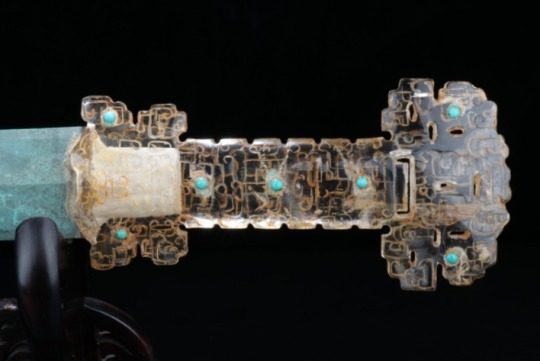
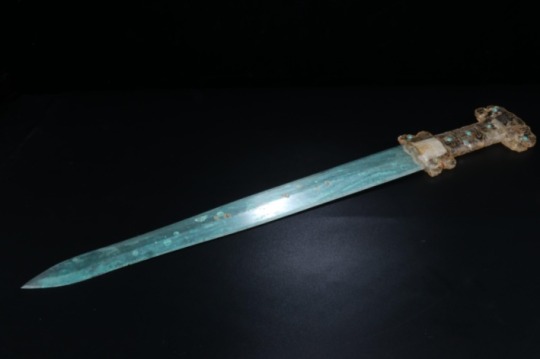
Chinese Bronze Sword With An Inlaid Rock Crystal, Turquoise and Gold Hilt
Warring States Period, Circa 4th - 2nd Century B.C.
#Chinese Bronze Sword With An Inlaid Rock Crystal Turquoise and Gold Hilt#Warring States Period#Circa 4th - 2nd Century B.C.#bronze#bronze sword#ancient artifacts#archeology#archeolgst#history#history news#ancient history#ancient culture#ancient civilizations#ancient china#chinese history#chinese art#art
2K notes
·
View notes
Text


🌞 Sun and Moon Pagodas | 日月双塔 🌚
Originally built in Guilin, Guangxi during the Tang dynasty (618-917) the pagodas were reconstructed in 2001.
#chinese culture#chinese history#Chinese architecture#buddhism#pagodas#tang dynasty#asian architecture#China#east asia#east Asian cultures#dynastic china
1K notes
·
View notes
Photo

Curious Ming Dynasty Hairpins in the shape of two shrimps. Found on a gilt silver hair cover excavated in a tomb in Shanghai. Exhibited at the Shanghai Museum of Art.
#ming dynasty#ming#chinese art#ancient china#chinese culture#hairpins#shrimps#shrimps art#antique jewelry#headdress#chinese jewelry#jewelry#jewelry design
3K notes
·
View notes
Text



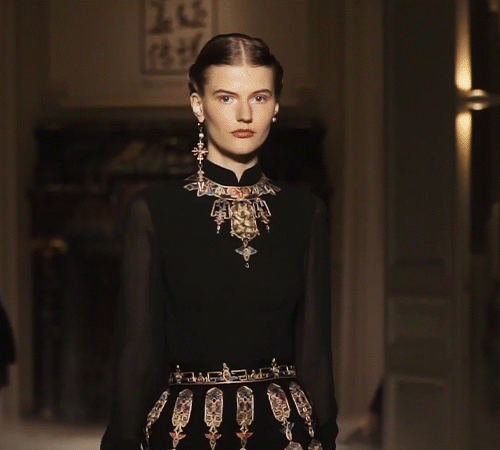
heaven gaia spring/summer 2019
#heaven gaia#fashion#runway#chinese fashion#beauty#style#catwalk#fashionedit#fashion details#cultural fashion#fantasy#mygifs#lookbook#royalcore#jewelry#headpiece#lookbooks#look#myfashionburden#happy new year
1K notes
·
View notes
Text
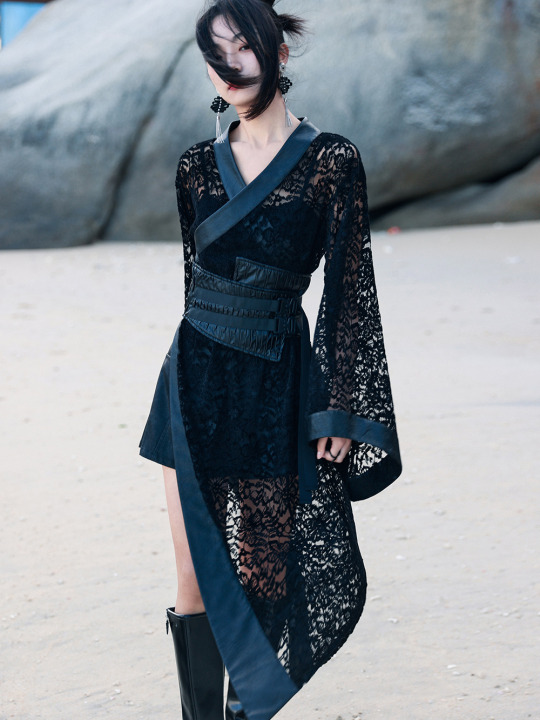

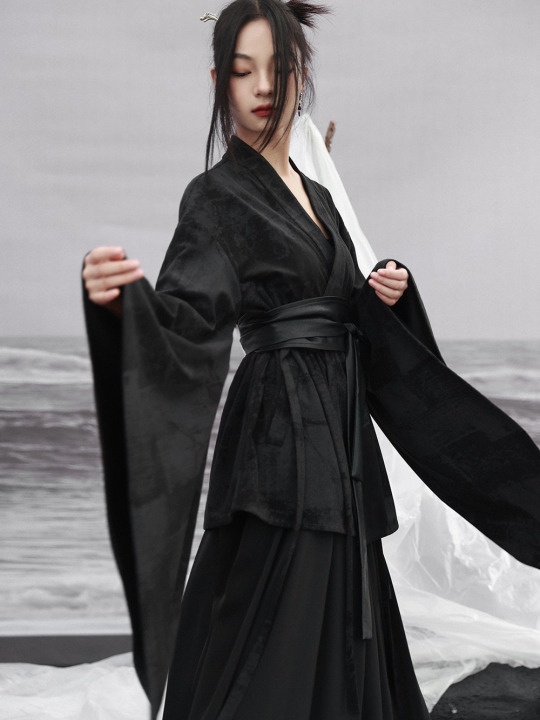





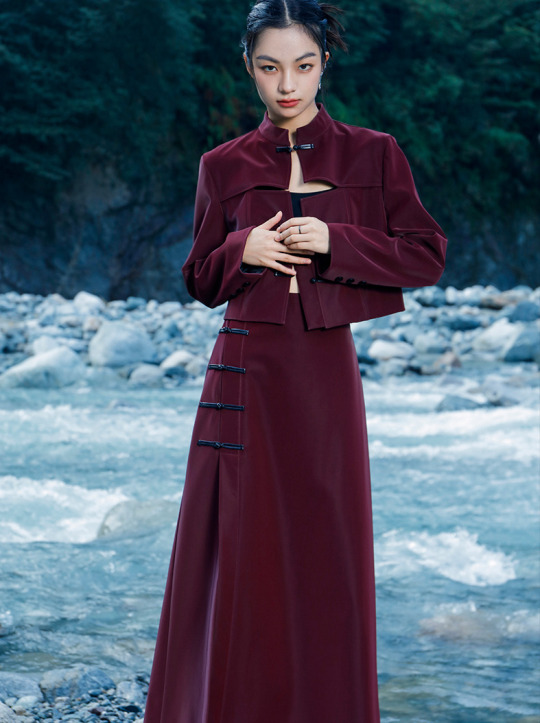
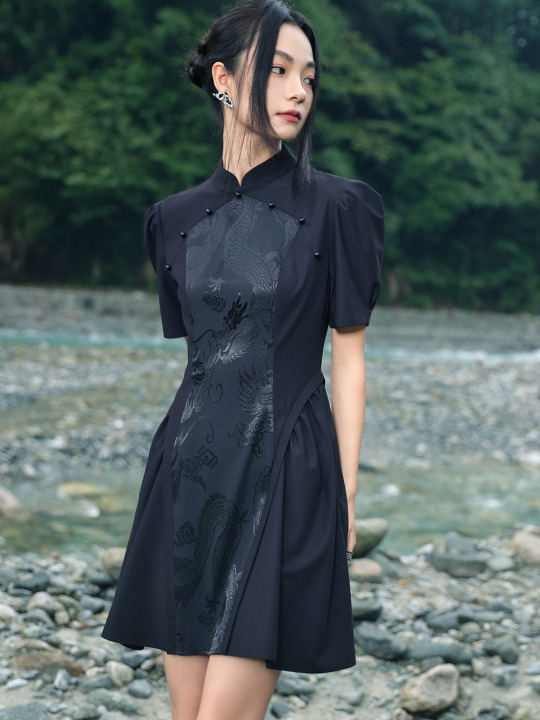





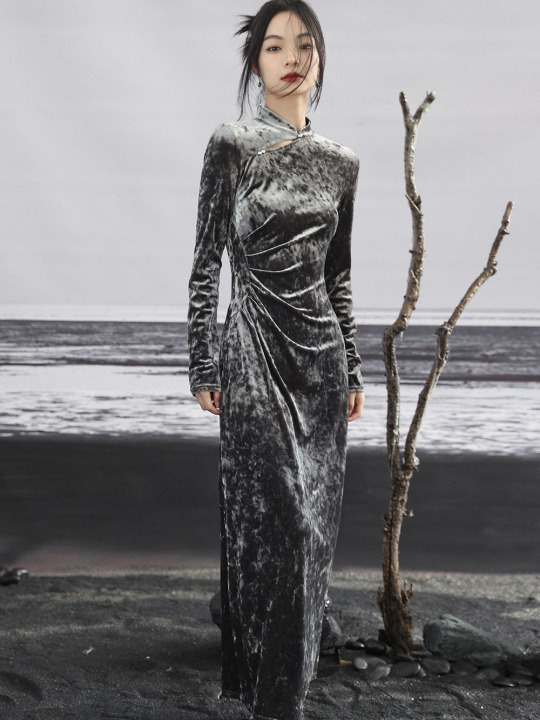

Since there's quite a lot of interest in Chinese-inspired cyberpunk and adjacent aesthetics, just wanted to share these neat "Chinese style meets the Matrix"-esque looks from popular brand 大青龙肆/Da Qing Long Si. There's also an English website here.
#大青龙肆#daqinglongsi#hanfu inspired#hanyuansu#qipao inspired#and etc#guofeng#xinzhongshi#cyberpunk#taobao#recs#chinese fashion#chinese clothing#chinese culture#china
1K notes
·
View notes
Text
A Queshan struck iron firework (打铁花; da2tie3hua1) performance to welcome the Year of the Dragon. Queshan struck iron fireworks differ from other iron fireworks due to the two-layered pergola and space required. This particular performance also features dragon dancing.
Please see my post here (my pinned post) for the full journey of how OP learned to strike iron fireworks as well as some other information and details about the art. (This is the video OP is referring to at the beginning of the video.)
*Before the countdown, OP is quoting the poem 青玉案·元夕 by 辛弃疾.
[eng by me + edited an ad out]
849 notes
·
View notes
Photo


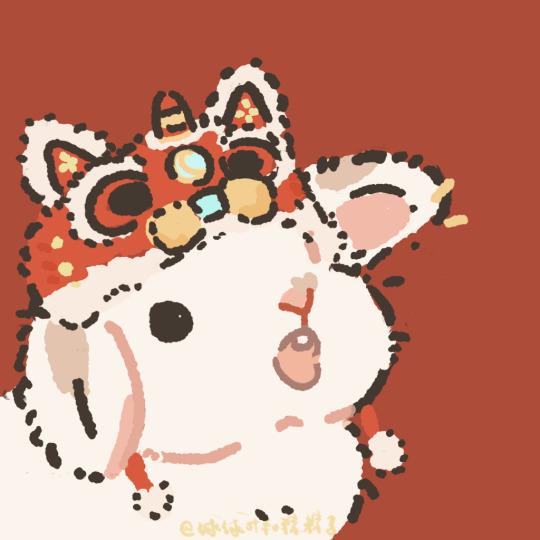

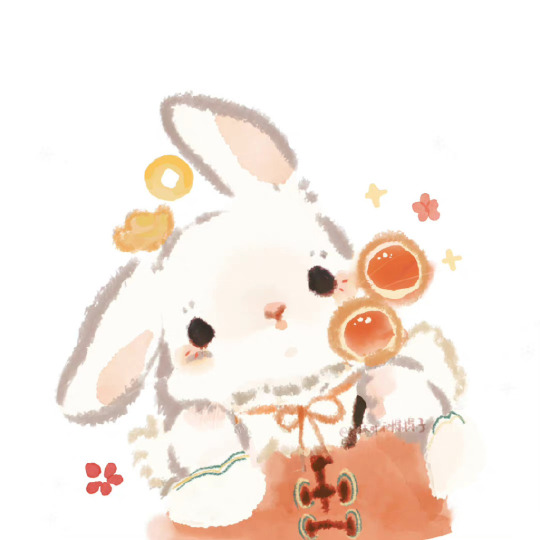

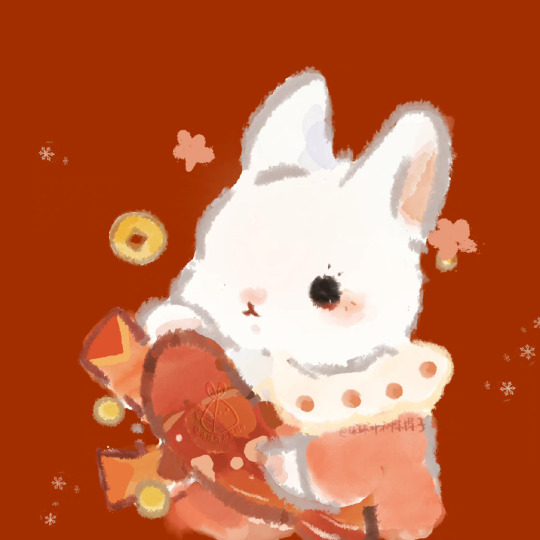
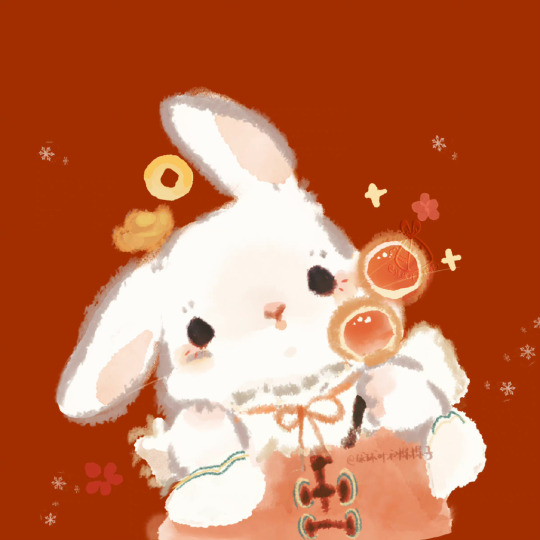


bunny for year of the rabbit by 球球叶和粽粽子
#china#art#paintings#illustrations#bunny#year of the rabbit#this year is maotu卯兔 in chinese culture#according to the attribute of the five elements#and tiangandizhi天干地支(ten heavenly stems and twelve terrestrial branches)#this year's rabbit is a black-water rabbit黑水兔
5K notes
·
View notes
Note
do you have any idea when people in china stopped bowing to each other as a greeting? it seems like the most common forms of greeting now is to shake hands or wave both which were introduced from the west. it's the same in taiwan too.
Tldr: It never stopped because Chinese people never had the practice of bowing in greeting the way that Japanese people did/do.
-
(Note: there are types of greetings that involve a sort of bowing (ketou), but this is reserved for special occasions)
Back in the day, the greetings were made by clasping one's hands in front of them in the direction of the person being greeted. There might be some head lowering/slight bowing involved but it's done in conjunction with the hand greeting. You can see various forms of this in historical dramas and even hanfu shows and shortform videos. The exact way one held their hands changed in some years but the general idea is the same.
Women's and men's hand greetings differed back in the day. A women's greeting was called 万福礼 wànfùlǐ and consisted of holding the hands in front of oneself and bending the legs, or holding hands at the hip, etc. The exact way to hold the hands also changes through the years. Women also do what is called 肃拜 sù bài, which is an earlier form of a women's greeting and includes getting on one's knees (thus the 拜).
Some examples of greetings:

Men's vs women's hand positions


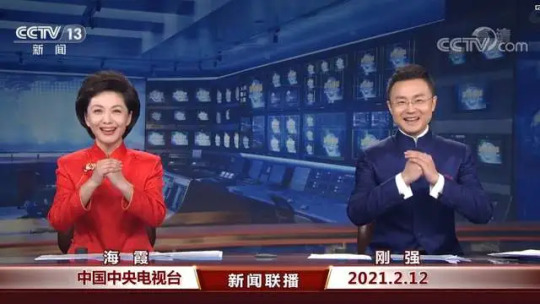
拱手礼 gōngshǒu lǐ ("cupped hands greeting"). The most common greeting. Top photo shows the gendered difference for proper etiquette for nowadays if you ware going to do it, for example, as a new year's greeting.
Bottom photos: I think if you look carefully in modern society, you can still see examples of this greeting in China. It is a gesture that can also be used to expresses one's gratitude. It is still there, it's just fell out of vogue in favor for waving and hand shaking.
This can also be seen in The video above shows Ming era 万福礼 as well as men's 揖礼. 作揖礼 zuòyī lǐ ("bow with clasped hand greeting") is kind of the same thing as 拱手礼, but 作揖 specifically includes a slight bow whereas 拱手礼 is merely the raising of the hands.
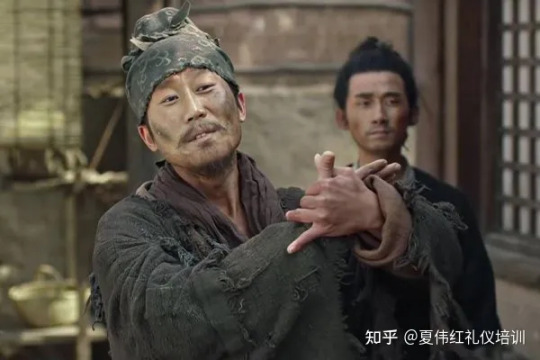
叉手礼 chāshǒu lǐ ("crossed hands greeting") popularised during the Western Jin - Song dynasties, seen in the drama "The Longest Day in Chang'an", which takes place in the Tang Dynasty. This particular greeting started out as one used by Buddhists in the Eastern Han dynasty.
https://zhuanlan.zhihu.com/p/489897518

抱拳礼 bàoquán lǐ ("cupped fist greeting"). This one is something done more so by martial artists. For men, you use your left hand to cover your right hand. For women, the opposite is true. It is also called 吉拜 jíbài when showing respect. If you flip your hand (keep in mind men/women do this the opposite way), it is called 凶拜 xiōngbài and it used to show respect to the dead. So one has to pay attention to this.
There's kind of a lot more etiquette rules you could get into but this answer has already sort of gone beyond the scope of your question lol. Chinese people wrote rites books over the many dynasties so actually there are descriptions of how these greetings were done and over time and that's how they are replicated in dramas and movies.
1K notes
·
View notes
Text

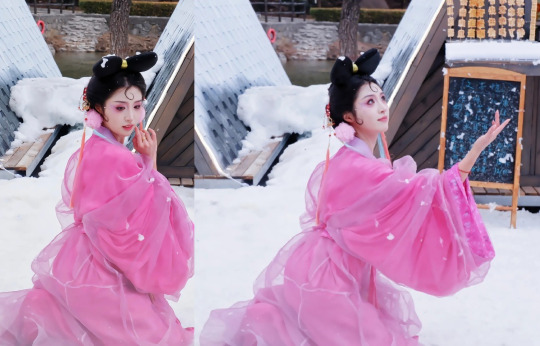
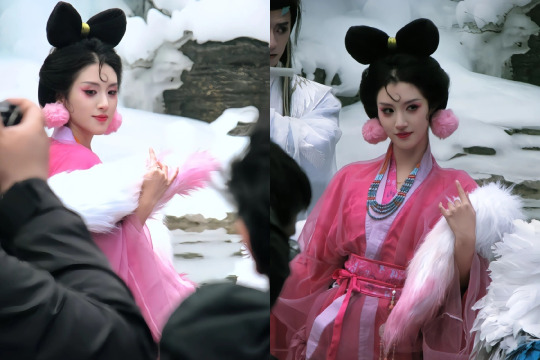

cosplay of daji妲己, a famous ancient chinese beauty transformed from the famous chinese yaoguai, jiuweihu九尾狐, i.e. nine tail fox (coser is shiba chongchuan十八重川)
#china#fashion#chinese fashion#video#hanfu#fun#douyin#styling based on 2003 chinese anime legend of nezha#chinese netizens comment that she's the best daji for her demeanor fits perfectly#chinese cosplayers will invite the audience to interact with them#female cosplayers will only interact with female audience#male cosers usually also interact only with female audience don't ask me why it's just cosplay culture there#that's why on douyin you see many cosers put their face or jaw on audience's hands willingly#including some physical contact#and in some individual cases#cosers will kiss on the cheek or hands of audience or something like that(only female coser to female audience)#just a brief on cosplay culture popular in china
533 notes
·
View notes
Text
another reason i think that xie lian felt an instant connection on the ox cart is because he and hua cheng both grew up in xianle.
there are maybe 4 people still alive that grew up in that culture. based on my own experience, you can pick up on things like accent, cadence, references, and humor that suggest a person is from the same place as you without consciously noticing it. that sense of comfort and similarity probably played into their instant chemistry.
#thinking about how they are bonded together by being the only people who remember their dead culture... augh it kind of makes me want to cr#as much fighting as fengqing do they are really the only people who will EVER understand each other's childhoods#which. aughhhh#there's a lovely modern au fic by heavensturtle called ''i'm just there to admire you.'' where they talk about chinese diaspora go read it#fics that mention paradise manor being in the xianle style also make me want to bawl. especially when fxmq notice it#other people that remember xianle: qi rong. jun wu. mei nianqing. yeah. none of those people are easy to talk to#buried deep in the xianle quartets heads are things like xianxia silly bands and xianxia nickelodeon and xianxia hi chew that LITERALLY#NOBODY ELSE IN THE ENTIRE WORLD REMEMBERS. DOES THAT NOT MAKE YOU FEEL INSANE#the immortality in tgcf and how it affects memory and sense of self and relationships. ourgh#i speak#tgcf meta#tgcf#tgcf spoilers#i guess?#tian guan ci fu#tgcf books#heaven official's blessing#hob#xie lian#hua cheng#hualian#feng xin#mu qing#fengqing#xianle trio#xianle quartet
654 notes
·
View notes